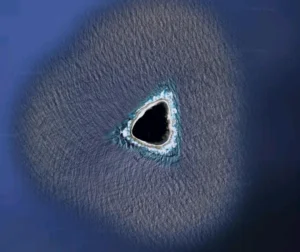In 2006, Earth’s smallest sibling fell from celestial grace: The International Astronomical Union (IAU) demoted the furthest body from the Sun from a planet to a dwarf planet. No one anticipated the backlash that followed. What was it about this little grey dwarf had everyone so on edge?

Clyde Tombaugh. Photo: Popular Science Monthly, June 1930
The discovery of Pluto
American astronomer Clyde Tombaugh discovered Pluto in 1930. The press exploded with excitement and heralded it as the ninth planet from the Sun. Tombaugh found it when he was looking for Percival Lowell’s theorized “Planet X”, a planet that Lowell suspected of perturbing Neptune and Uranus.
Lowell believed that this planet existed past Neptune. When Tombaugh found Pluto, it seemed to fit the bill. It did not take long for textbooks to be reprinted with this new information, and for children’s cartoons and pop culture to pay homage to the newly discovered planet. Its choice of name was even left to the public. A little girl named Venetia Burney suggested it, in the ongoing tradition of assigning Greco-Roman mythological figures to heavenly bodies.
This all changed in the 1970s when astronomers realized that they had overestimated Pluto’s mass. They discovered one of Pluto’s moons, Charon, which allowed them to make a better calculation. To their dismay, they found that Pluto was not the size of Earth, as once believed, but a sixth of it. It’s not even as big as our own moon. This changed the game completely.
Kuiper Belt Objects: Was Pluto just one of these?
In the 1990s, astronomers found a wider network of objects beyond Neptune’s orbit and officially named it the Kuiper Belt. Many of these Kuiper Belt Objects are near to Pluto in mass. In 2000, the Hayden Planetarium in New York received backlash after an exhibit did not include Pluto in its presentation of the Solar System.
Further complications occurred when another almost Pluto-sized Kuiper Belt Object named Eris (ironically, the Greek goddess of discord) was found in 2005. This begged the question: Is Pluto merely one of these objects?

Pluto and its moon Charon. Photo: NASA/JHUAPL/SwRI
Wrote astronomer Sethane Howard, “Pluto is no longer unique. So many such objects have been found that it became necessary to redefine what makes a planet.”
The IAU needed to rectify this issue. While this may seem like a trivial matter, it can impact the way that we understand space. It decided to create an official classification system. While Pluto was round, had its own atmosphere, seasons, complex geography, moons and orbited the Sun like the other planets, the definition went beyond these features.
According to the IAU, besides the more standard features that Pluto satisfies, a planet has also “cleared the neighborhood around its orbit”. Because of its fellow Kuiper Belt Objects, that is where Pluto falls short.
Once-glorious Pluto, now Number 134340
Thereafter, Pluto came a mere dwarf planet, a new category. A dwarf planet has not cleared the neighborhood around its orbit and is also not a moon. Somewhat ignominiously, given its former status as the ninth planet in our solar system, Pluto was also assigned the number 134340.

Pluto and Charon. Photo: NASA
The decision sparked outrage that went beyond the inconvenience of altering textbooks, posters, exhibits, and pop culture references. Some astronomers believed that this definition impacted the status of other planets like Jupiter, Neptune, and Earth, which are near the so-called asteroid belt. Some believed that the move was a show of political strength: The IAU did it because they can.
The backlash
However, the backlash evolved into something more personal and emotional than expected. The public defended the little guy. People circulated petitions and wore protest t-shirts. Even a new verb appeared: to pluto, meaning to devalue or downgrade a person or thing. August 26 has officially become Pluto Demotion Day.
Why did it bother people so much? If Pluto had become a dwarf planet or one of the mere Kuiper Belt Objects much earlier, would that have made a difference? Nevertheless, while some astronomers have joined the protest crowd, many others believed that this clarification was for the best and allowed more possibilities in our analysis of space.
Perhaps because astronomers considered it a planet for so long, Pluto has been well-studied, for an object so far away. It has an atmosphere of mostly carbon monoxide, nitrogen, and methane, is 2,302km wide, full of glaciers and icy mountain ranges, an ever-frosty surface temperature ranging from -226° to -240°C, five moons, and an orbital period of 248 Earth years. A NASA website gives the public an idea of how dark Pluto is because of its vast distance, 5.9 billion kilometres, from the Sun: Plug in your location and you’ll see what high noon looks like on Pluto. It’s pretty dark.
A cultural betrayal
In 2006, the same year that Pluto lost its planetary status, the New Horizons space probe began its journey to fly past Pluto and other objects in the Kuiper Belt. It arrived in 2015 and snapped photos of the surface and other nearby objects.

Artist’s rendition of the New Horizons space probe. Photo: edobric/Shutterstock
Logically, reclassifying the planet made sense. Thousands of objects, some of them as big as Pluto itself, were turning up. Just because we discovered Pluto first, why should we treat it differently?
Nevertheless, culturally Pluto’s demotion remains a betrayal. Little Pluto is still a planet in many people’s hearts.






